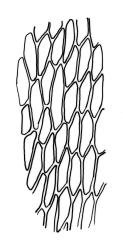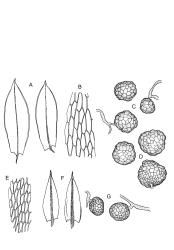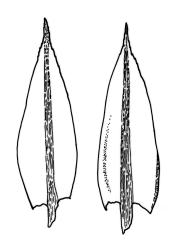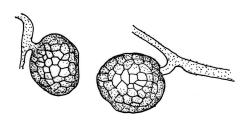- ≡ Gemmabryum ruderale (Crundw. & Nyholm) J.R.Spence, Phytologia 89: 111 (2007)
Stems c. 5 mm, beset below with purple rhizoids. Leaves evenly spaced on stem, erect-spreading when moist, becoming more erect and narrowed when dry, ovate- or elliptic-lanceolate, acute, denticulate above, weakly bordered and ± recurved at margins, not decurrent, 0.7–1.3 × 0.2–0.3 mm, with lamina forming c. 0.9 of entire length; mid laminal cells firm-walled, c. 39–66 × 10 µm; marginal cells elongate in 2–3 rows, forming a weak border. Costa stout and excurrent. Tubers ± spherical, (75–)120–195(–250) µm diam., bright orange, c. 10–12 cells across, with cells not protruding.
Reportedly dioicous. Perichaetial leaves to 1.5 × 0.5 mm. Perigonia terminal, with bracts to 1.6 mm. Setae c. 28 mm, red-brown; capsules pendent, pyriform, red-brown, c. 2.3 mm; operculum mammillate. Exostome teeth yellow-brown, endostome segments fenestrate; cilia well-developed, in groups of 3, appendiculate, ± the height of the teeth. Spores c. 10 µm, nearly smooth.
Crundwell & Nyholm 1964, fig. 2 a–k; Smith 2004, fig. 189, 10–13; Porley 2008, p. 64.
SI: Nelson (Onekākā), Otago (sterile material from Abbotsford, Waipori River). The Onekākā material is fertile.
Probably adventive. Smith (2004) provided a summary of the scattered, primarily northern hemisphere distribution of this species.
Known only from one Nelson L.D. and two Otago L.D. sites. Although the Onekākā collection by J. Tisdall (WELT M036076) is ample and fertile, male plants could not be demonstrated. It came from a "road verge at base of concrete bridge". Both sterile Otago collections were from the margins of railway lines and one was growing with Funaria hygrometrica on "ash & clay".
Bryum ruderale is treated here as one of six N.Z. members of the "B. erythrocarpum complex" sensu Crundwell & Nyholm (1964). The complex is discussed in more detail under B. duriusculum.
All three N.Z. collections are distinctive by their tuber and rhizoid morphology and colour.







